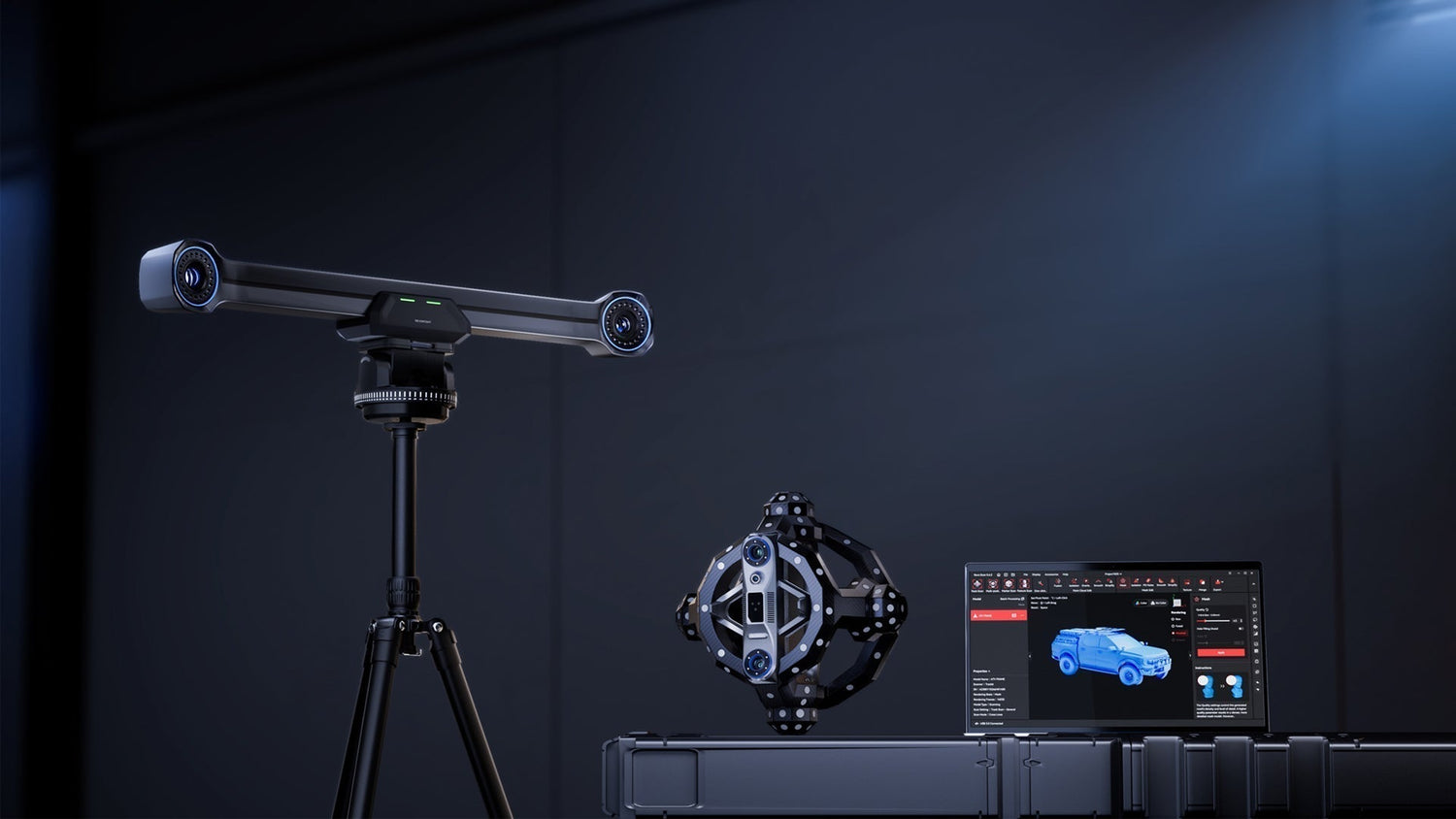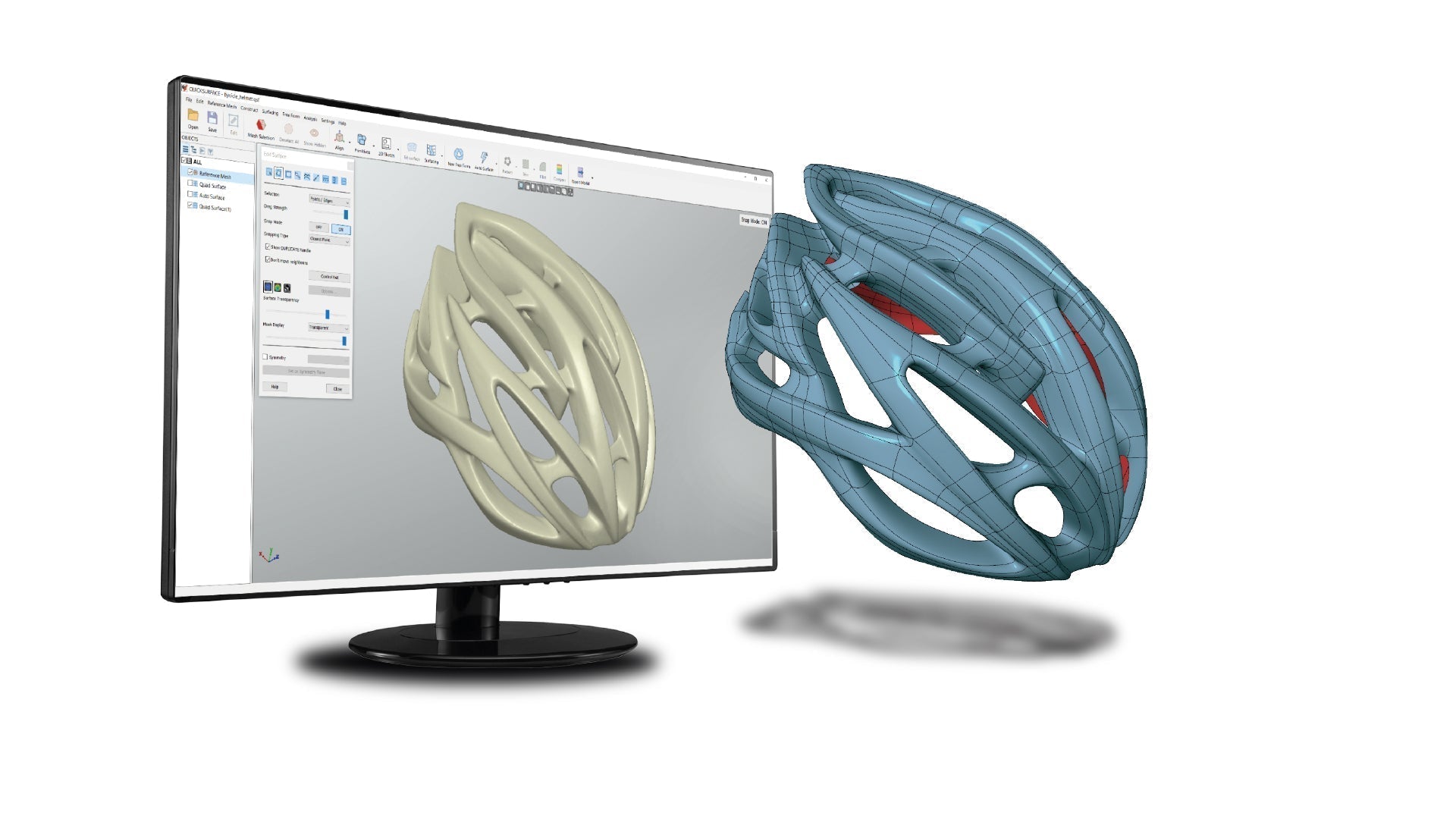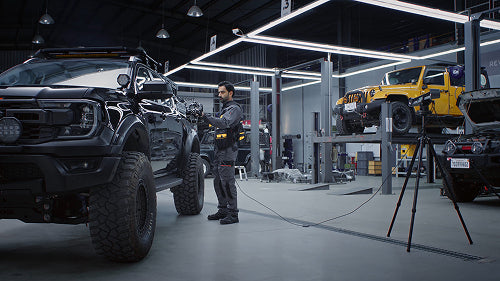The Revopoint Trackit 3D scanner system introduces a powerful new tool for manufacturers at a highly cost-effective price compared to similar tracking solutions. Unlike traditional structured light or other marker-based systems, Trackit offers a marker-free optical tracking workflow that minimizes setup time, operator dependence, and cumulative error in large or complex scans.
For manufacturers seeking to digitize their quality control, prototyping, and reverse engineering workflows, understanding how to effectively integrate Trackit into daily operations is critical. Below, we’ll outline the core considerations, technical setup, and process optimization strategies needed to deploy Trackit efficiently in an industrial setting.
Trackit Overview
The Trackit 3D scanning system consists of two main components. The handheld 3D scanner has 30 crossed blue laser lines for quick scanning of surfaces and a single blue laser line for scanning holes. It also includes an infrared tracking base station with two depth cameras that monitor the scanner’s spatial movement in real-time. This setup enables the scanner to operate freely without requiring markers to be applied to the object being scanned. This is especially helpful when scanning large workpieces, as applying markers can be a time-consuming process.

Output formats include PLY, STL, OBJ, FBX, and more, ensuring broad compatibility with CAD and CAM software. The system’s effective tracking volume is up to 11 cubic meters, with volumetric accuracy rated at 0.02 + 0.04 mm x L (m), which is sufficient for most industrial and metrology-grade use cases.
Deployment Planning
Proper deployment requires more than just hardware setup; it involves optimizing workspace conditions, aligning workflows, and training personnel. When implemented with these factors in mind, Trackit can accelerate reverse engineering , shorten inspection cycles, and increase data fidelity across your production pipeline.
Workstation Requirements
Trackit requires a powerful workstation for optimal performance.
Minimum PC Requirements
System Version: Windows 10/11 (64-bit)
RAM: ≥ 32 GB
CPU: Intel i7 13th Gen or better/AMD Ryzen 7 7000 series or better
GPU: NVIDIA GeForce RTX 3050 (8 GB)
USB: 3.0 or above
Recommended PC Requirements
System Version: Windows 10/11 (64-bit)
RAM: ≥ 64 GB
CPU: Intel i9 12th Gen or better
GPU: NVIDIA RTX 4060 (8 GB) or better
USB: 3.0 or above
Physical Layout and Lighting
The IR base station (Tracker) has a working range of up to 4 meters, and it performs best when mounted on a vibration-free structure. Avoid direct infrared interference, such as heat lamps or sunlight on reflective surfaces, which may impact optical tracking.
![]()
When scanning larger workpieces, such as a car, you’ll need to reposition the base station during the scanning process to fully capture the entire vehicle. Ensure your work area has sufficient space to position the base station when scanning large items.
Ideally, set up a controlled lighting environment to maintain consistent lighting across scans.
Calibration and Setup Time
The entire auto calibration process, encompassing the scanner, tracker, and hand-eye calibration, takes approximately 20 to 25 minutes. This step ensures high precision and should be repeated if the scanner and base have been transported to a new environment, the environment's temperature has changed by more than ± 5°C, left unused for an extended period, or if the accuracy test fails.

Consider integrating a short accuracy check into the daily startup routine to help maintain consistency across scans. Guided by the calibration wizard in the Revo Trackit software, the process requires no special training.
Workflow Integration
Depending on your application, such as reverse engineering, first-article inspection, or quality control, the integration will vary slightly. Below are the common workflows and how Trackit fits into each one.
Scanning for CAD Conversion (Reverse Engineering)
● Scan the required area or the entire workpiece, depending on your needs.
● Process the scan data in Revo Trackit, then export your mesh to scan-to-CAD software like Quicksurgace or Revo Design for transformation into a CAD. Finally, export your CAD file to your preferred CAD software for final-stage processing.
Inspection and Quality Control
● Use Trackit to scan the machined or molded part.
● Open the scan data in Revo Measure or other metrology measurement software.
● Compared the scan data to a CAD reference using point cloud or mesh-to-CAD deviation, 2D cross-section, feature comparison, or GD&T analysis.
● Export deviation maps, pass/fail reports, or inspection certificates. Integrate results into your PLM or ERP system for enhanced traceability and accurate record-keeping.
Tooling and Fixture Verification
● Capture a high-accuracy scan of the tool or fixture when first manufactured or validated.
● At defined maintenance intervals, re-scan the object to check for wear, deformation, warping, or tool shift.
● Use Revo Measure or external tools to compare new scans to the baseline. Archive data for traceability or rebuild planning.
Optimization Strategies
To maximize Trackit’s utility, the following considerations should be taken into account.
Standardize Scan Protocols
Create Standard Operating Procedures that define the scanning distance, angle, and path coverage to ensure consistency and accuracy. This minimizes operator variability and ensures repeatability across shifts or locations.
Create Part libraries
Build a scan library of commonly produced parts. These baseline meshes can be used for rapid comparison or deviation testing without the need to rescan reference models.
Operator Training
While Trackit is intuitive, training on scan coverage, mesh quality evaluation, and data export workflows will improve consistency and reduce scan times.

Integration with CAD and PLM Systems
Trackit produces mesh forms compatible with major CAD suites, including SolidWorks, Siemens NX, and Autodesk Inventor. However, the mesh-to-CAD conversion process often requires intermediate tools, such as Revo Design or QuickSurface, to facilitate a speedy transformation.
For organizations using PLM or ERP systems, it’s possible to link scanned part IDs or deviation reports to product records. Integrations can be built with middleware that associates STL or OBJ files with lot numbers, inspection logs, and corrective actions.
Considerations for Scaling
If you’re planning to deploy multiple Trackits across production lines or facilities, consider the following.
Dedicated Scan Stations
Build fixed scanning workstations equipped with all necessary components to perform scans, as well as maintain scanning quality through regular calibrations.
Multi-user Licensing
Ensure your software stack (Revo Measure, Revo Design, CAD tools) can support multiple users or floating licenses.
Data Security
Scan data files should be encrypted, regardless of access control, especially when scanning proprietary tools or customer parts, to ensure data security.



Leave a comment
This site is protected by hCaptcha and the hCaptcha Privacy Policy and Terms of Service apply.